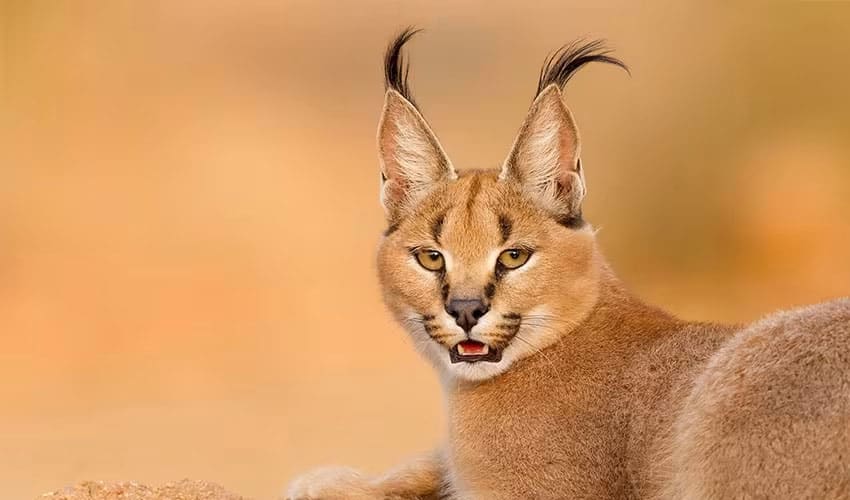The caracal, derived from the Turkish “karakulak,” meaning “black ear,” is a striking wild cat known for its distinctive physical characteristics and remarkable hunting abilities. This medium-sized feline sports a coat of tawny or reddish-gold fur, complemented by a white chin, throat, and underside, creating a vivid contrast that adds to its majestic appearance. However, it is the caracal’s large, pointy ears tipped with elegant black tufts that truly set it apart, serving as its most iconic feature. These ear tufts are not merely ornamental; they play critical roles in the caracal’s survival and communication strategies. Serving as visual signals, the tufts help caracals communicate with each other, conveying mood and intentions. Additionally, these tufts are thought to enhance the cat’s hearing by funneling sounds into the ears, thus aiding in the detection of prey and predators alike.
The caracal’s prowess as a hunter is unmatched, attributed to its exceptional speed and agility. Capable of taking down prey up to three times its size, the caracal exemplifies the apex predator’s traits within its environment. This remarkable ability is not only a testament to its physical capabilities but also to its strategic hunting techniques. The caracal’s coat provides it with perfect camouflage, blending seamlessly into the surrounding environment and allowing it to approach its prey undetected. Furthermore, the soles of its feet are cushioned with stiff fur, enabling this formidable predator to stalk its prey nearly silently.
Interestingly, despite their carnivorous diet, caracals possess a unique trait in their feeding habits. Unable to digest the fur of their prey, they meticulously remove it using their sharp claws before consuming the meat. This behavior underscores the caracal’s adaptability and the specialized nature of its predatory lifestyle, ensuring that it derives the maximum nutritional value from its catch without the complications of indigestible material.
Distribution
 Afghanistan
Afghanistan Algeria
Algeria Angola
Angola Benin
Benin Botswana
Botswana Burkina Faso
Burkina Faso Burundi
Burundi Cameroon
Cameroon Central Af. Rep.
Central Af. Rep. Chad
Chad Côte D’ivoire
Côte D’ivoire DR Congo (Kinshasa)
DR Congo (Kinshasa) Djibouti
Djibouti Egypt
Egypt Eritrea
Eritrea Eswatini
Eswatini Ethiopia
Ethiopia Gambia
Gambia Ghana
Ghana Guinea-Bissau
Guinea-Bissau Guinea
Guinea India
India Iran
Iran Iraq
Iraq Israel
Israel Jordan
Jordan Kazakhstan
Kazakhstan Kenya
Kenya Kuwait
Kuwait Lebanon
Lebanon Lesotho
Lesotho Libya
Libya Malawi
Malawi Mali
Mali Mauritania
Mauritania Morocco
Morocco Mozambique
Mozambique Namibia
Namibia Niger
Niger Nigeria
Nigeria Oman
Oman Pakistan
Pakistan Saudi Arabia
Saudi Arabia Senegal
Senegal Somalia
Somalia South Africa
South Africa Sudan
Sudan Syria
Syria Tajikistan
Tajikistan Tanzania
Tanzania Togo
Togo Tunisia
Tunisia Turkey
Turkey Turkmenistan
Turkmenistan UAE
UAE Uganda
Uganda Uzbekistan
Uzbekistan Yemen
Yemen Zambia
Zambia Zimbabwe
ZimbabweDid you know?
- The distinctive ear tufts serve as a “flag” to convey an animal’s status, attitude, and intention.
- They can leap up to 1.8 m (6 ft) high on their powerful muscular hind legs to strike birds in midair. Sometimes, they would climb trees, pounce on nests and hide their prey just like leopards.
- They are also called “desert lynx” or “Persian lynx” and were previously regarded as true lynxes based on superficial resemblance but that view was discredited with detailed studies. They are not lynx.
- They miaow, hiss, or spit according to their mood, just like any other cat, but distinctive “coughing calls” can be heard from caracal during mating season.
- Caracal is vulnerable to a variety of pressures and threats that differ in extent and intensity as a result of its wide geographic distribution ( across Asia, North Africa, and at least 36 Sub-Saharan African countries), which includes a broad spectrum of conditions, leading to their extremely diverse local population trends.
- Caracals are frequently prosecuted because they are capable of taking small domestic livestock. Habitat destruction, fragmentation by linear infrastructure, road kills, and attacks by feral dogs are threats they encounter at various places.
- According to a recent study, caracals around Cape Town City regularly hunt in places where there is a higher danger of exposure to organochlorines. Their blood and fat tissues are found to be contaminated with harmful “forever-chemicals”.
Anything we've missed?
Help us improve this page by suggesting edits. Glory never dies!
Suggest an editGet to know me
Terrestrial / Aquatic
Altricial / Precocial
Polygamous / Monogamous
Dimorphic (size) / Monomorphic
Active: Diurnal / Nocturnal
Social behavior: Solitary / Pack / Herd
Diet: Carnivore / Herbivore / Omnivore / Piscivorous / Insectivore
Migratory: Yes / No
Domesticated: Yes / No
Dangerous: Yes / No






